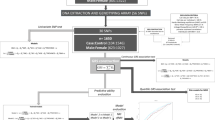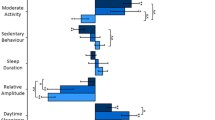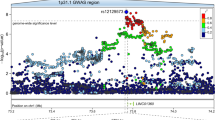Abstract
Angiotensin-converting enzyme (ACE) is assumed to influence the activity of the hypothalamic-pituitary-adrenocortical (HPA) system, which shows hyperactivity in the majority of patients with major depression. The ACE gene, known to be associated with cardiovascular disorders, which in turn are accompanied with an increased susceptibility for depression, is therefore a promising candidate gene for affective disorders. We investigated the genetic association between 35 single-nucleotide polymorphisms (SNPs) and an insertion/deletion (I/D)-polymorphism in the ACE gene and the susceptibility for unipolar major depression together with the genetic association with ACE serum activity and functional parameters of the HPA system. Two independent case/control samples with a total of 843 unrelated unipolar depressed patients and 1479 healthy controls were investigated. A case/control sample was screened to detect genetic associations with unipolar major depression. In addition, a replication sample was used to confirm the detected associations and to further investigate functional consequences of the genetic variants associated with depression. In the screening sample, two SNPs within the ACE gene were significantly associated with unipolar major depression. The association with unipolar major depression of one SNP (rs4291) located in the promoter region of the ACE gene was confirmed in our replication sample. The T-allele of this SNP was associated with depression and depressed T-allele carriers showed higher ACE serum activity and HPA-axis hyperactivity. Variants of the ACE gene such as SNP rs4291 are suggested susceptibility factors for unipolar major depression. We could show that SNP rs4291 influences ACE activity and HPA-axis hyperactivity and might therefore represent a common pathophysiologic link for unipolar depression and cardiovascular disease.
This is a preview of subscription content, access via your institution
Access options
Subscribe to this journal
Receive 12 print issues and online access
$259.00 per year
only $21.58 per issue
Buy this article
- Purchase on Springer Link
- Instant access to full article PDF
Prices may be subject to local taxes which are calculated during checkout





Similar content being viewed by others
References
Arregui A, Mackay AV, Spokes EG, Iversen LL . Reduced activity of angiotensin-converting enzyme in basal ganglia in early onset schizophrenia. Psychol Med 1980; 10: 307–313.
Bardelay C, Mach E, Worcel M, Hunt P . Angiotensin-converting enzyme in rat brain and extraneural tissues visualized by quantitative autoradiography using 3H-trandolaprilate. J Cardiovasc Pharmacol 1989; 14: 511–518.
Jeunemaitre X . Genetic polymorphisms in the renin–angiotensin system. Therapie 1998; 53: 271–277.
Rigat B, Hubert C, Alhenc-Gelas F, Cambien F, Corvol P, Soubrier F . An insertion/deletion polymorphism in the angiotensin I-converting enzyme gene accounting for half the variance of serum enzyme levels. J Clin Invest 1990; 86: 1343–1346.
Jezova D, Ochedalski T, Kiss A, Aguilera G . Brain angiotensin II modulates sympathoadrenal and hypothalamic pituitary adrenocortical activation during stress. J Neuroendocrinol 1998; 10: 67–72.
Holsboer F, Barden N . Antidepressants and hypothalamic-pituitary-adrenocortical regulation. Endocr Rev 1996; 17: 187–205.
Baghai TC, Schule C, Zwanzger P, Minov C, Zill P, Ella R et al. Hypothalamic-pituitary-adrenocortical axis dysregulation in patients with major depression is influenced by the insertion/deletion polymorphism in the angiotensin I-converting enzyme gene. Neurosci Lett 2002; 328: 299–303.
Baghai TC, Schule C, Zwanzger P, Minov C, Schwarz MJ, de Jonge S et al. Possible influence of the insertion/deletion polymorphism in the angiotensin I-converting enzyme gene on therapeutic outcome in affective disorders. Mol Psychiatry 2001; 6: 258–259.
Baghai TC, Schule C, Zwanzger P, Zill P, Ella R, Eser D et al. Influence of a functional polymorphism within the angiotensin I-converting enzyme gene on partial sleep deprivation in patients with major depression. Neurosci Lett 2003; 339: 223–226.
Arinami T, Li L, Mitsushio H, Itokawa M, Hamaguchi H, Toru M . An insertion/deletion polymorphism in the angiotensin converting enzyme gene is associated with both brain substance P contents and affective disorders. Biol Psychiatry 1996; 40: 1122–1127.
Meira-Lima IV, Pereira AC, Mota GFA, Krieger JE, Vallada H . Angiotensinogen and angiotensin converting enzyme gene polymorphisms and the risk of bipolar affective disorder in humans. Neurosci Lett 2000; 293: 103–106.
Pauls J, Bandelow B, Ruther E, Kornhuber J . Polymorphism of the gene of angiotensin converting enzyme: Lack of association with mood disorder. J Neural Trans 2000; 107: 1361–1366.
Segman RH, Shapira Y, Modai I, Hamdan A, Zislin J, Heresco-Levy U et al. Angiotensin converting enzyme gene insertion/deletion polymorphism: case–-control association studies in schizophrenia, major affective disorder, and tardive dyskinesia and a family-based association study in schizophrenia. Am J Med Genet 2002; 114: 310–314.
Niu T, Chen X, Xu X . Angiotensin converting enzyme gene insertion/deletion polymorphism and cardiovascular disease: therapeutic implications (article). Drugs 2002; 62: 977–993.
Musselman DL, Evans DL, Nemeroff CB . The relationship of depression to cardiovascular disease: epidemiology, biology, and treatment. Arch Gen Psychiatry 1998; 55: 580–592.
American Psychiatric Association. Diagnostic and statistical manual of mental disorders, 4th edn rev. American Psychiatric Association: Washington DC, 1994.
Wittchen HU, Höfler M, Gander F, Pfister H, Storz S, stün B et al. Screening for mental disorders: performance of the Composite International Diagnostic – Screener (CID-S). Methods Psychiatr Res 1999; 8: 59–79.
Muller S, Martin S, Koenig W, Hanifi-Moghaddam P, Rathmann W, Haastert B et al. Impaired glucose tolerance is associated with increased serum concentrations of interleukin 6 and co-regulated acute-phase proteins but not TNF-alpha or its receptors. Diabetologia 2002; 45: 805–812.
Hamilton M . The Hamilton rating scale for depression. In: Sartorius N, Ban TA (eds). Assessment of Depression. Springer: Berlin, 1986, pp 143–152.
Butcher JN, Dahlstrom WG, Tellegen A, Kaemmer B . Minnesota Multiphasic Personality Inventory (MMPI-2) Manual for Administering and Scoring. University Minnesota Press, Minneapolis, 1989.
Costa PT, McCrae RR . Revised NEO Personality Invertory (NEO PI-R) and NEO Five Factor Inventory. Professional Manual. In: Anonymous (ed). Psychological Assessment Resources. Psychological Assessment Resources Inc.: Odessa, 1992.
Cloninger CR . A systematic method for clinical description and classification of personality variants. A proposal. Arch Gen Psychiatry 1987; 44: 573–588.
Tang K, Fu DJ, Julien D, Braun A, Cantor CR, Koster H . Chip-based genotyping by mass spectrometry. Proc Natl Acad Sci USA 1999; 96: 10016–10020.
Shanmugam V, Sell KW, Saha BK . Mistyping ACE heterozygotes. PCR Methods Appl 1993; 3: 120–121.
Lindpaintner K, Pfeffer MA, Kreutz R, Stampfer MJ, Grodstein F, LaMotte F et al. A prospective evaluation of an angiotensin-converting-enzyme gene polymorphism and the risk of ischemic heart disease. N Engl J Med 1995; 332: 706–711.
Sasieni PD . From genotypes to genes: doubling the sample size. Biometrics 1997; 53: 1253–1261.
Wittke-Thompson JK, Pluzhnikov A, Cox NJ . Rational inferences about departures from Hardy–Weinberg equilibrium. Am J Hum Genet 2005; 76: 967–986.
Lewontin RC . On measures of gametic disequilibrium. Genetics 1988; 120: 849–852.
Weale ME, Depondt C, Macdonald SJ, Smith A, Lai PS, Shorvon SD et al. Selection and evaluation of tagging SNPs in the neuronal-sodium-channel gene SCN1A: implications for linkage-disequilibrium gene mapping. Am J Hum Genet 2003; 73: 551–565.
Nielsen DM, Ehm MG, Weir BS . Detecting marker-disease association by testing for Hardy–Weinberg disequilibrium at a marker locus. Am J Hum Genet 1998; 63: 1531–1540.
Feder JN, Gnirke A, Thomas W, Tsuchihashi Z, Ruddy DA, Basava A et al. A novel MHC class I-like gene is mutated in patients with hereditary haemochromatosis. Nat Genet 1996; 13: 399–408.
Gater R, Tansella M, Korten A, Tiemens BG, Mavreas VG, Olatawura MO . Sex differences in the prevalence and detection of depressive and anxiety disorders in general health care settings: report from the World Health Organization Collaborative Study on Psychological Problems in General Health Care. Arch Gen Psychiatry 1998; 55: 405–413.
Schachter F, Faure-Delanef L, Guenot F, Rouger H, Froguel P, Lesueur-Ginot L et al. Genetic associations with human longevity at the APOE and ACE loci. Nat Genet 1994; 6: 29–32.
Schug J, Overton GC . TESS: Transcription Element Search Software on the WWW. http://www.cbil.upenn.edu/tess 1998 (Technical Report CBIL-TR-1997-1001-v0.0).
Shrivastava A, Calame K . An analysis of genes regulated by the multi-functional transcriptional regulator Yin Yang-1. Nucleic Acids Res 1994; 22: 5151–5155.
Strawhecker JM, Betz NA, Neades RY, Houser W, Pelling JC . Binding of the 97 kDa glucocorticoid receptor to the 5′ upstream flanking region of the mouse c-Ha-ras oncogene. Oncogene 1989; 4: 1317–1322.
Heuser I, Yassouridis A, Holsboer F . The combined dexamethasone/CRH test: a refined laboratory test for psychiatric disorders. J Psychiatr Res 1994; 28: 341–356.
Ising M, Kunzel HE, Nickel T, Modell S, Holsboer F . The combined dexamethasone/CRH test as a potential surrogate marker in depression. Prog Neuro-Psychopharmacol Biol Psychiatry 2005; 29: 1085–1093.
Skidgel RA, Erdos EG . The broad substrate specificity of human angiotensin I converting enzyme. Clin Exp Hypertens A 1987; 9: 243–259.
Aguilera G, Kiss A, Luo X, Akbasak BS . The renin–angiotensin system and the stress response. Ann NY Acad Sci 1995; 771: 173–186.
Ganong WF . Angiotensin II in the brain and pituitary: contrasting roles in the regulation of adenohypophyseal secretion. Horm Res 1989; 31: 24–31.
Raasch W, Wittmershaus C, Dendorfer A, Voges I, Pahlke F, Dodt C et al. Angiotensin II inhibition reduces stress sensitivity of hypothalamo-pituitary-adrenal axis in spontaneously hypertensive rats. Endocrinology 2006; 147: 3539–3546.
Glorioso N, Dessi-Fulgheri P, Alagna S, Rubattu S, Soro A, Madeddu P et al. Angiotensin converting enzyme inhibition reduces ACTH release due to hypoglycaemia. Clin Exp Hypertens A 1987; 9: 665–670.
Morganti A, Ambrosi B, Sala C, Cianci L, Bochicchio D, Turolo L et al. Effects of angiotensin II blockade on the responses of the pituitary–adrenal axis to corticotropin-releasing factor in humans. J Cardiovasc Pharmacol 1987; 10: S167–S169.
Kunzel HE, Binder EB, Nickel T, Ising M, Fuchs B, Majer M et al. Pharmacological and nonpharmacological factors influencing hypothalamic-pituitary-adrenocortical axis reactivity in acutely depressed psychiatric in-patients, measured by the Dex-CRH test. Neuropsychopharmacology 2003; 28: 2169–2178.
Higaki J, Baba S, Katsuya T, Sato N, Ishikawa K, Mannami T et al. Deletion allele of angiotensin-converting enzyme gene increases risk of essential hypertension in Japanese men: the Suita Study. Circulation 2000; 101: 2060–2065.
O'Donnell CJ, Lindpaintner K, Larson MG, Rao VS, Ordovas JM, Schaefer EJ et al. Evidence for association and genetic linkage of the angiotensin-converting enzyme locus with hypertension and blood pressure in men but not women in the Framingham Heart Study. Circulation 1998; 97: 1766–1772.
Celentano A, Mancini FP, Crivaro M, Palmieri V, Ferrara LA, De S et al. Cardiovascular risk factors, angiotensin-converting enzyme gene I/D polymorphism, and left ventricular mass in systemic hypertension. Am J Cardiol 1999; 83: 1196–1200.
Gardemann A, Fink M, Stricker J, Nguyen QD, Humme J, Katz N et al. ACE I/D gene polymorphism: presence of the ACE D allele increases the risk of coronary artery disease in younger individuals. Atherosclerosis 1998; 139: 153–159.
Carney RM, Freedland KE, Jaffe AS . Depression as a risk factor for coronary heart disease mortality. Arch Gen Psychiatry 2001; 58: 229–230.
Carney RM, Freedland KE, Miller GE, Jaffe AS . Depression as a risk factor for cardiac mortality and morbidity: A review of potential mechanisms. J Psychosomat Res 2002; 53: 897–902.
Frasure-Smith N, Lesperance F, Juneau M, Talajic M, Bourassa MG . Gender, depression, and one-year prognosis after myocardial infarction. Psychosom Med 1999; 61: 26–37.
Frasure-Smith N, Lesperance F, Talajic M . Depression and 18-month prognosis after myocardial infarction. Circulation 1995; 91: 999–1005.
Frasure-Smith N, Lesperance F, Talajic M . Depression following myocardial infarction. Impact on 6-month survival. JAMA 1993; 270: 1819–1825.
Penninx BW, Beekman AT, Honig A, Deeg DJ, Schoevers RA, van Eijk JT et al. Depression and cardiac mortality: results from a community-based longitudinal study. Arch Gen Psychiatry 2001; 58: 221–227.
Lederbogen F, Deuschle M, Heuser I . Depression–a cardiovascular risk factor. Internist (Berlin) 1999; 40: 1119–1121.
Whyte EM, Mulsant BH, Vanderbilt J, Dodge HH, Ganguli M . Depression after stroke: a prospective epidemiological study. J Am Geriatr Soc 2004; 52: 774–778.
Zubenko GS, Nixon RA . Mood-elevating effect of captopril in depressed patients. Am J Psychiatry 1984; 141: 110–111.
Vuckovic A, Cohen BM, Zubenko GS . The use of captopril in treatment-resistant depression: an open trial. J Clin Psychopharmacol 1991; 11: 395–396.
Baran L, Siwanowicz J, Nowak G, Przegalinski E . Captopril lacks the antidepressant-like activity in animal models. Pol J Pharmacol Pharm 1991; 43: 265–270.
Hallas J . Evidence of depression provoked by cardiovascular medication: a prescription sequence symmetry analysis. Epidemiology 1996; 7: 478–484.
Acknowledgements
This project was supported by grants from the Friedrich-Baur-Foundation (FBI 0046/2002 and 0051/2000), the Foerderprogramm fuer Forschung und Lehre of the Ludwig-Maximilian-University of Munich (Reg. no. 372) and the Deutsche Forschungsgemeinschaft (DFG BA 2309/1-1) (LMU), as well as the Bavarian Ministry of Commerce and the Federal Ministry of Education and Research (BMBF) in the framework of the National Genome Research Network (NGFN) (Reg. 01GS0481) (MPI). We would like to thank S de Jonge and K Neuner for expert technical assistance, J Klesing for support in the preparation of the manuscript and Dr Ruppert and his team at the GRC for genotyping. We are responsible for the contents of this publication.
Author information
Authors and Affiliations
Corresponding author
Rights and permissions
About this article
Cite this article
Baghai, T., Binder, E., Schule, C. et al. Polymorphisms in the angiotensin-converting enzyme gene are associated with unipolar depression, ACE activity and hypercortisolism. Mol Psychiatry 11, 1003–1015 (2006). https://doi.org/10.1038/sj.mp.4001884
Received:
Revised:
Accepted:
Published:
Issue Date:
DOI: https://doi.org/10.1038/sj.mp.4001884
Keywords
This article is cited by
-
How Does COVID-19 Affect the Neurobiology of Suicide?
Current Psychiatry Reports (2021)
-
Association of ACE Gene Insertion/Deletion Polymorphism with Suicidal Attempt in an Iranian Population
Biochemical Genetics (2021)
-
Chronically infused angiotensin II induces depressive-like behavior via microglia activation
Scientific Reports (2020)
-
The renin–angiotensin system: a possible new target for depression
BMC Medicine (2017)
-
Influence of ACE gene on differential response to sertraline versus fluoxetine in patients with major depression: a randomized controlled trial
European Journal of Clinical Pharmacology (2016)



